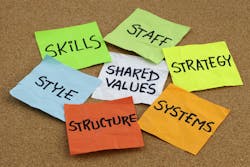A Thoughtful Safety Program Won’t Save a Thoughtless Culture
In navigating the challenges of plant safety, striking a balance is key. While a well-crafted safety program forms a foundation, it’s not the sole determinant of success. Beyond procedural excellence, the anchor that determines the success of your safety initiative is your organizational culture.
Culture impacts everything. Peter Drucker, the great leadership guru, once said, “Culture eats strategy for breakfast.” Yep! That’s pretty accurate. Culture doesn’t only impact safety, though. It impacts turnover, quality, production, and all types of KPIs.
So, it is no surprise that our data shows those facilities with top-quartile cultures have 75% fewer lost-time accidents and over 80% fewer recordable incidents as compared to the bottom-quartile facilities.
Let me give you an example of the burden organizations carry from the cost of an unsafe work environment. A facility we examined a few years back had 12 lost-time accidents in eight months. OSHA would calculate this at 12 x $41,000, for a total direct and indirect cost to the plant of $492,000. From a profit perspective, you would need an additional $16.4 million in revenue to make up this cost in profit. The culture scores, incidentally, for this facility, were at the bottom of the Denison scale on the benchmark.
If your safety initiative is all about the x’s and o’s (process), the culture of your facility will dictate whether you win or not.
As someone who has spent the last 25 years looking at culture data with thousands of companies, specifically in the manufacturing industry, I’ve developed a strong intuition about the root cause. It’s important to recognize that culture doesn’t just develop at the corporate level. Sure, it may influence it. But if you look at a large corporation with 70 or so facilities, you will see a handful at the top outperforming the others, and another handful at the bottom acting like an anchor to your business.
Then, of course, a large chunk in the middle. That is a typical normal curve. The common denominator in this dynamic? Management, and more specifically, leadership. Whether it’s the performance of some or the underwhelming results of others, the crux of the matter often boils down to effective leadership. It’s not just about being competent managers; it’s about leading with excellence. That, in essence, is the root cause.
What the Data Shows
The Denison Organizational Culture Survey has been used by thousands of organizations over the last 25 years. This is a benchmarked culture assessment that compares the culture of those using it to an index of 1000+ other organizations. Denison has also developed a “safety module” that is benchmarked as well. Our team at Denison looked at 230 manufacturing facilities that conducted both the culture assessment and the safety survey. We also paid close attention to level: how managers and employees looked at the various factors of safety. The results say it all.
Figure one represents the sample of top quartile organizations (55 facilities) we reviewed. The facilities are additionally divided by manager versus employee to see how each group is aligned around safety. The percentile difference ranges from no difference (0) to a percentile difference of eighteen (18). However, even in the case where there is a large difference, “Considering everything, this organization is a very safe place” is still in the 69th percentile, which means on average the facilities in this group of 55 plants rank safety higher than 68% of the organizations in the benchmark. That is what we like to see!
Figure 1
Figure two is a difference story. This group of sixty (60) represents the facilities who fell in the bottom quartile of the Denison Database (< 25th percentile). Interestingly, the questions that mention leaders show the largest gaps. You could argue the leaders may be out to lunch in how they perceive their part of safety.
Figure 2
Furthermore, when you look at how the leaders scored on the culture survey, the only score where they crossed over the 50th percentile (average) was on “The leaders and managers practice what they preach,” which fell in the 64th percentile (Figure 3). The score from that same question by employees was the second lowest at a two (2), giving it the largest gap for the bottom quartile facilities.
Figure 3
We broke it down further. What cultural characteristics were the most highly correlated with the safety index when you look at each group? From here, we learned what people “feel” within the walls of each facility. The Denison Organizational Culture Survey (DOCS) has 48 culture items. We looked at the top 10 drivers of each by running correlations on each item in the Safety Index.
In the bottom group, we end up seeing facilities who still grapple with internal issues. They are inwardly focused, and a new leader to the organization may describe the culture as toxic. The severity rate would be above industry standard. There would also be quite a lot of churn of employees. With people coming and going and HR working tirelessly to get new people in the door, there is a steady flow of those who are on their way out, as well. This creates a stress on the system, as overtime is burning people out. The steady influx of new people on the floor is causing errors, which lead to quality, production and ultimately customer issues.
All the while, those leaving—many probably in the millennial and other younger generations, with more mobility—are flocking to Glassdoor and Indeed leaving poor ratings and embarrassing reviews about your organization for the world to see. Both of those sites may seem harmless, but they are where your potential new employees under the age of 42 go to review what the culture of your organization is like. So, basically, your culture will impact your labor pool.
Within the walls of the top quartile group, people would probably describe those around them as family. They would feel supported by not only those around them, but from people in other areas, too. They would see leaders within the facility as approachable and personable, and feel they have access to leaders at all levels. The leaders will model good behavior.
Unlike the bottom group—where “leaders practice what they preach was the largest gap,” the top group has a smaller gap and both the managers and leaders had percentile scores well above average. People in this organization will live out their values, especially when it comes to working safely. People hold each other accountable. There is little fear in the environment, so people are allowed to learn from their mistakes (as long as those mistakes are not made over and over). The people have not only been engaged in safety teams, but they also helped create them and have bought in. The safety record for these facilities is likely better than industry. The turnover rate of employees is also better, probably closer to 15%. This allows the facility to run like clockwork. More than likely, their Glassdoor and Indeed scores are high, giving them the pick of the litter. All of this works out to be an organization that is meeting their production, delivery, safety, quality and other KPIs.
What’s Next?
How do you effectively tackle this challenge? The data points to culture – not merely safety culture. While having well-established programs is important, true transformation goes beyond what looks good on paper. The crux lies in looking at the managers and supervisors on the floor, not just in terms of their managerial abilities but in how they lead people. To kickstart a culture change, the focus must shift to how the facility is being led, necessitating a baseline and a starting point. Begin by understanding your current culture, then dive into the differences between managerial and employee perceptions.
Our data highlights a common trend: Managers often view things more positively than employees, which can shape the narrative (until financials come into play). The key lies in developing leaders at the ground level. While those leading the organization have taken all the knocks and risen to the top, fostering a culture of continuous development is crucial. Exceptional organizations don’t just wait for talent to emerge; they actively nurture bench strength. Having a great leadership development program is a good start. But this doesn’t mean mere “manager training” – it means true leadership training, imparting essential people skills. Ultimately, this investment will not only redefine your culture but will also resonate powerfully with your bottom line.
About the Author
Jay Richards
Partner
Jay Richards is a member of the founding team at Denison, a firm based in Ann Arbor, Michigan, specializing in corporate culture and leadership development. For 20 years, Jay has worked with manufacturing firms in improving their culture and leadership.



